Comprehensive Guide to Kite Surf Lessons for All Levels
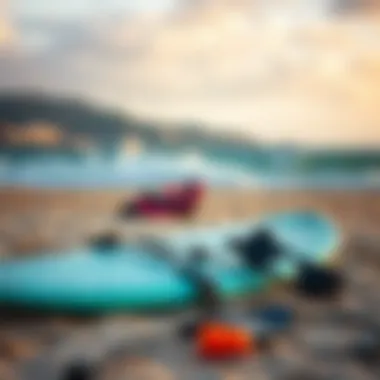
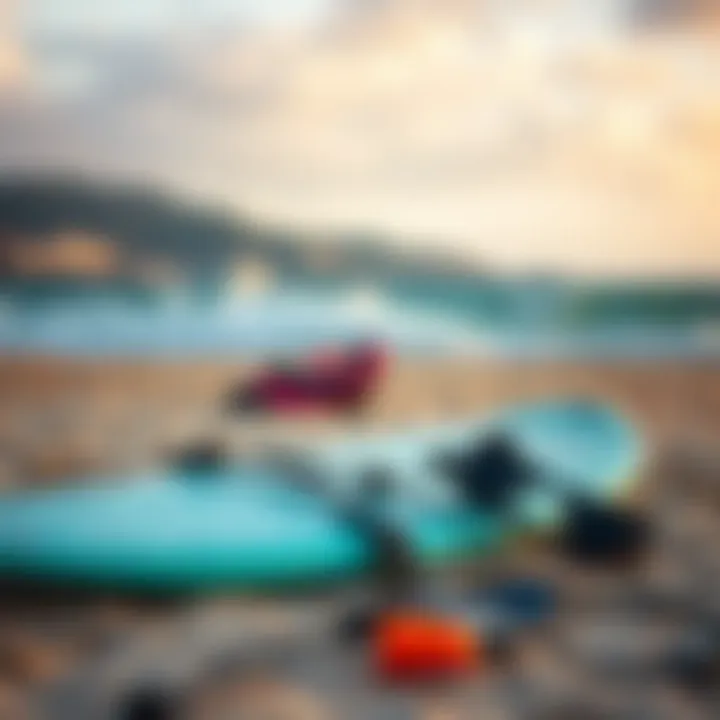
Intro
Kite surfing, an exhilarating blend of surfing and paragliding, has captured the hearts of many adventure seekers around the globe. It's not just a water sport; it’s a way of life that allows enthusiasts to harness the power of the wind while riding the waves. This guide aims to provide a thorough understanding of kite surf lessons, catering to both beginners eager to dip their toes into this dynamic sport and seasoned riders looking to elevate their skills.
Getting started in kite surfing involves more than just jumping on a board with a kite in hand. Preparation is key, and understanding the essentials can make all the difference between an extraordinary experience and a chaotic one. We will break down crucial components like techniques, gear, safety measures, and prime locations. Following these insights, learners can expect to have a smoother sailing on their journey from novice to advanced kiteboarder.
Whether you're seeking the thrill of carving through waves or merely riding with the wind, this guide is designed to boost your confidence and competence on the water. Let’s delve into the techniques crucial for kiteboarding enthusiasts—those fundamental and advanced maneuvers that will take your surfing experience to the next level.
Techniques for Kiteboarding Enthusiasts
Beginner Techniques
Understanding the fundamentals of kite surfing is paramount for beginners. Here are a few basic techniques to get you started:
- Wind Awareness: Recognizing the wind direction is crucial. Always face the kite into the wind, ready to launch.
- Power Stroke: This refers to pulling the control bar inward to create tension in the lines. It’s how you gain power from the kite.
- Body Dragging: Learning to body drag without the board helps you understand kite control and how to navigate the water.
- Water Start: This is the transition into riding the board and the first step towards being independent on the water. Focus on keeping your kite at a 45-degree angle.
Advanced Maneuvers
As you progress, you may want to incorporate more advanced techniques into your repertoire:
- Jumping: Using the upward lift from the kite, you can learn to jump higher, landing back smoothly.
- Kiteloops: This move involves looping the kite while airborne. It requires precision and timing for successful execution.
- Surfboard Tricks: Advanced riders can experiment with tricks like 360 spins and flips to showcase their skills while riding waves.
Mastering these techniques takes time, practice, and patience, but they can elevate your kiteboarding experience.
Equipment Reviews
Choosing the right equipment is crucial in kite surfing. The kite and board's performance can vastly impact your experience. Here’s a detailed overview:
Kite Reviews
Investing in a good kite can mean the difference between a smooth ride and a frustrating one. Here’s what to look for:
- Size: Kites come in various sizes. Smaller kites work better in high winds, while larger kites suit lighter winds.
- Type: Consider different types like C-kites for performance riding or hybrid kites for versatility.
Board Reviews
Selecting a board that matches your skill level is equally important:
- Shape: Boards vary in shapes; directional boards are for surf-style riding, while twin tips are great for tricks.
- Material: High-quality materials enhance durability. Boards made from carbon fiber are often lighter and more responsive.
Be sure to read reviews on specific models and try them out to see what fits your style best. Consider checking platforms like Reddit or Facebook Groups for personal experiences and discussions.
As you gear up for kite surfing, this guide will continue to unravel insights about safety, lesson progression, and locations ideal for honing your craft. Prepare to ride the wind and embrace the waves!
Prelude to Kite Surfing
Kite surfing, a thrilling fusion of surfing and paragliding, invites enthusiasts to ride the waves while harnessing the power of the wind. This segment explores the fundamentals of kite surfing, shedding light on its significance as a recreational activity and sport. You see, understanding kite surfing isn’t just about the skills you acquire; it's about appreciating the experience as a whole—the dance between the ocean and the sky.
What is Kite Surfing?
At its core, kite surfing is a water sport where a person rides on a board while being pulled by a large, controllable kite. This unique activity allows riders to glide across water surfaces, perform jumps, and execute tricks—all while using wind power. Essentially, you're navigating the open water with a kite overhead, generating lift and forward motion.
Notably, kite surfing presents a variety of disciplines within itself, including freestyle, wave riding, and racing. Each discipline emphasizes different skills and techniques, catering to diverse preferences. The versatility makes kite surfing appealing to many, regardless of their background. The beauty lies in the adrenaline rush coupled with the serene connection to nature.
Historical Background
Kite surfing's evolution is woven into a tapestry of various influences and innovations. It first emerged in the late 1970s, drawing on the concepts of windsurfing and kite flying. Early pioneers experimented with various kite designs and board types. The trajectory changed dramatically in the 1990s, specifically when kites became more advanced in construction and control.
This transformative period also saw legendary figures like Bruno Legaignoux, who contributed heavily to the design of modern kites, leading to the first commercially available kite surf equipment. By the early 2000s, kite surfing began to gain traction as a mainstream water sport, largely due to advancements in safety features and the growth of instructional schools.
Kite surfing's appeal is not only due to the thrill of gliding across the water; it also symbolizes a lifestyle choice for many enthusiasts. It's a dynamic combination of skill, balance, and understanding of natural elements. Every new kiter experiences a growing bond with the waters and winds, a connection that continues to draw individuals to the sport from all corners of the globe, showcasing its vibrant community and ongoing evolution.
“Kite surfing is not just a sport; it’s an expression of freedom found in the embrace of nature.”
Understanding Kite Surf Lessons
Kite surfing is not just a sport; it's an experience that encapsulates the thrill of harnessing wind and waves for an adrenaline rush like no other. Understanding kite surf lessons is foundational for anyone looking to dive into this exciting adventure. With the right guidance, novice riders can transition from absolute beginners to competent surfers, while seasoned individuals can sharpen their skills or learn new tricks. By investing time in lessons, participants not only enhance their personal safety but also gain an understanding of the dynamics involved in kite surfing.
Objectives of Kite Surf Lessons
The primary aim of kite surf lessons is to equip learners with essential competencies. Here are the core objectives that underpin any structured kite surf lesson:
- Safety Proficiency: At the forefront, kite surf lessons stress on safety. Instructors emphasize understanding weather conditions, wind patterns, and how to handle equipment properly.
- Technical Skills: Developing the necessary skills to control a kite and maintain balance on a surfboard is essential. Lessons focus on building coordination and strength, which are vital for effective movement on the water.
- Situational Awareness: Learning to be aware of your surroundings, which includes awareness of other kite surfers, boat traffic, and environmental hazards, is an integral part of the training process. This consideration helps prevent accidents and promotes a safe riding environment.
- Equipment Familiarization: Understanding the various components and their functions—such as kites, lines, and boards—is crucial. Lessons allow students to get acquainted with different types of equipment and how best to use them.
- Progression Paths: Effective kite surf instruction offers clear pathways for aspiring kite surfers to advance their skills. Whether it’s mastering jumping techniques or learning how to ride in tricky conditions, a well-structured lesson prepares learners for different scenarios.
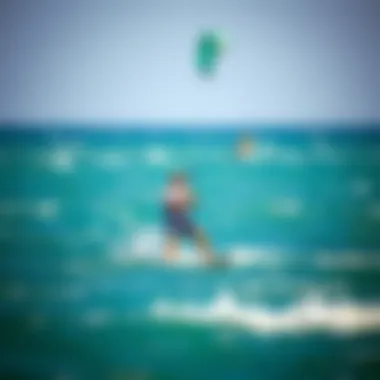
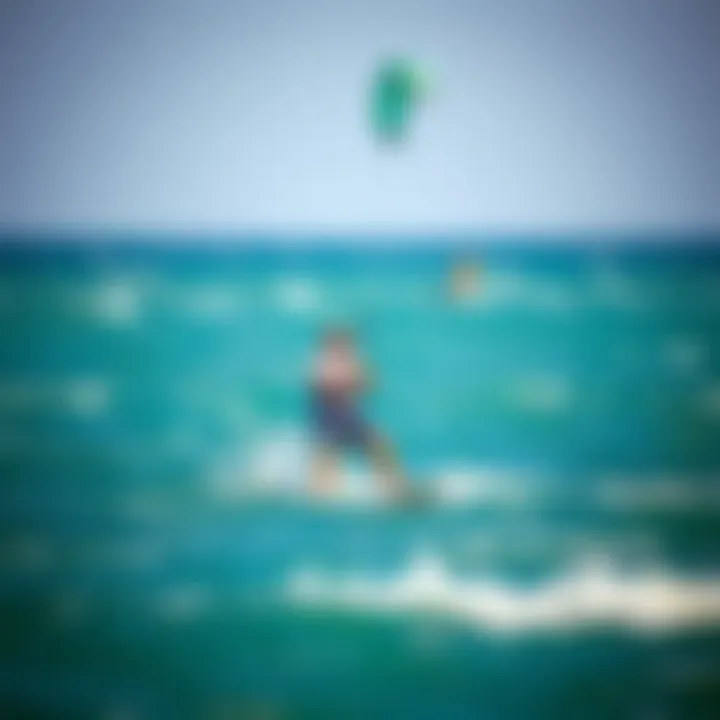
"The better your foundation, the higher you can fly!" - A wise proverb that rings true in kite surfing.
Who Should Take Lessons?
Almost anyone can try kite surfing, but lessons serve as a type of gateway to this world. Here’s a breakdown of who benefits most from structured kite surfing education:
- Absolute Beginners: Those with no prior experience can easily feel overwhelmed by the equipment and technique. Lessons demystify the process and build confidence.
- Water Sports Enthusiasts: Individuals already involved in other water sports—like windsurfing or paddleboarding—can quickly adapt to kite surfing. However, professional guidance can enhance skills and safety.
- Adventure Seekers: For thrill-seekers and adrenaline junkies, kite surfing lessons offer a thrilling introduction to the sport while ensuring a focus on safety and skill development.
- Individuals Seeking a Challenge: Kite surfing is certainly not for the faint of heart. People looking to push their boundaries in endurance and skill appreciate the structured approach of lessons.
Essential Equipment for Beginners
When it comes to diving into kite surfing, having the right equipment is as crucial as learning the techniques themselves. The essential equipment for beginners not only enhances your learning experience but also plays a significant role in your safety and overall enjoyment of the sport. From kites to boards and safety gear, every piece of equipment serves a distinct purpose that aligns with your journey in kiteboarding.
Kites: Types and Selection
Selecting the right kite is a fundamental step in your kite surfing journey. Kites come in various shapes, sizes, and designs, each tailored for different wind conditions and skill levels. For newcomers, it's wise to start with an all-around kite that provides versatility and stability across varying wind strengths.
- Incomplete Edges: Kites with rounded shapes are easier to handle and offer more stability, which is perfect for novices learning to control their movements.
- Size Matters: The size of the kite affects its power. A larger kite captures more wind, making it ideal for light wind conditions, while smaller kites are better suited for stronger winds, allowing for more control.
It’s also advisable to consult with instructors or specialists at your local kite shop to find a kite that best matches your intended usage while considering local wind patterns.
Boards: Choosing the Right Fit
Choosing the right board can significantly affect your performance on the water. Kiteboards vary in shape, size, and type, and they should match your skill level and riding style. Beginners typically benefit from larger boards, which provide better stability and easier take-offs. Here are some factors to keep in mind:
- Size: Bigger boards are more forgiving and easier to balance on, providing additional flotation, which helps when you’re starting out.
- Shape: Look for directional boards if you're interested in riding in one direction, or twin tips if you want to experiment with both ways. Twin tips allow for easier turns and are generally recommended for beginners.
- Material: Lightweight materials make for a more responsive ride, while sturdier designs can withstand harsher conditions. It ultimately comes down to personal preference and what feels right in motion.
Safety Gear: Must-Have Items
Safety should never take a back seat in any sport, especially one like kite surfing. Proper safety gear is indispensable to protect you from potential injuries. Here’s a list of vital safety items:
- Harness: This is the link between you and your kite, making it foundational for control. Look for comfortable options that provide good support.
- Life Jacket: To keep you buoyant and provide extra safety in rough conditions.
- Helmet: Protecting your head from falls or collisions is paramount. Choose a helmet designed specifically for water sports.
- Impact Vest: This provides cushion against falls, offering both comfort and additional floatation.
- Wetsuit: Depending on the water temperature, a wetsuit can keep you warm. It’s also protective against potential scrapes with surfboards or debris.
Essential gear not only enhances your kite surfing experience but also ensures you remain safe while mastering the elements of the sport.
In summary, equipping yourself with the right kites, boards, and safety gear is foundational for beginners. Such considerations can make all the difference in how you progress and enjoy kite surfing. As you gear up for your first lessons, remember that each component is geared towards fostering both fun and safety as you learn to harness the wind.
Finding the Right Instructor
Choosing the right instructor for kite surfing can set the tone for your entire journey in this exhilarating sport. The instructor you select can significantly influence not only your learning rate but also your overall enjoyment of each session. A skilled instructor plays multiple roles: they are your mentor, your safety guide, and often your cheerleader. Throughout the learning process, it's essential to feel comfortable and confident, which underscores the vital need to pick someone who meets your unique needs and learning style.
Qualities to Look For
When searching for an instructor, there are several key qualities that should be on your checklist:
- Experience: A seasoned instructor has likely seen and handled all sorts of situations on the water. This experience translates into better safety measures, quicker troubleshooting, and an overall smoother learning process.
- Communication Skills: A good instructor should be able to explain concepts clearly. You want someone who breaks things down without speaking in jargon that might confuse a newbie.
- Patience: Learning to kite surf can be frustrating. An effective instructor needs to have ample patience to guide you through each hurdle and celebrate small victories.
- Passion for Teaching: The best instructors don't just love kite surfing; they love teaching it. Their enthusiasm can be contagious and make the learning experience much more enjoyable.
Accreditation and Certification
It's important to inquire about the qualifications of your prospective instructor. Many regions require instructors to be certified by recognized organizations, such as the International Kiteboarding Organization (IKO) or the British Kite Sports Association (BKSA). These certifications ensure that instructors have undergone rigorous training and adhere to safety guidelines.
By opting for an accredited instructor, you also gain reassurance that they possess a standard set of skills relevant to teaching. This knowledge fosters an environment where safety, teaching quality, and progression are at the forefront. Moreover, certain instructors may have additional certifications like first-aid training, which is an excellent plus for peace of mind.
Evaluating Teaching Methods
The teaching methods employed by an instructor play a crucial role in how effectively you learn. Different instructors might use unique approaches, so it's beneficial to evaluate:
- Personal Learning Style Compatibility: Are you more of a visual learner or do you grasp concepts better through hands-on practice? Have a candid conversation with the instructor about their teaching style and see if it meshes well with how you learn best.
- Structured Curriculum: A solid lesson plan that gradually builds on new skills can be a sign of a good instructor. Check if they have certain progression milestones set to guide your learning journey.
- Use of Technology: Some instructors utilize video analysis or digital tools to enhance the learning experience. If having feedback through technology is important for you, then find someone who incorporates this into their lessons.
Ultimately, the relationship you have with your instructor can make a world of difference in your kite surfing experience. Trust your instincts, and don't shy away from asking questions. It’s your adventure; make sure you’re in good hands!
The right instructor can transform a daunting experience into an exhilarating journey in kite surfing.
For those looking into the kiteboarding community for recommendations or additional resources, consider visiting sites like reddit.com/r/kiteboarding or local kiteboarding clubs listed on Facebook.
The Learning Process in Kite Surfing
The journey through kite surfing is not just about mastering the wind and water; it’s a nuanced learning curve that begins with the basics and culminates in advanced skills. Understanding the learning process is crucial for anyone stepping into this thrilling sport. Not only does it paint a clear picture of the path ahead, but it also sets realistic expectations. Whether you’re a complete novice or someone with a grain of experience, knowing what each stage entails will aid in your growth and confidence.
Being aware of the stages in the learning process allows kiteboarders to approach lessons methodically, absorbing the necessary skills bit by bit. Not to mention, it enables instructors to tailor their teaching to match the learner's proficiency level, enhancing the overall experience.
Beginner Lessons: What to Expect
As a rookie in kite surfing, stepping onto the scene can feel more daunting than a tightrope walk across a raging river. But fear not, the first lessons are designed to ease you into the sport.
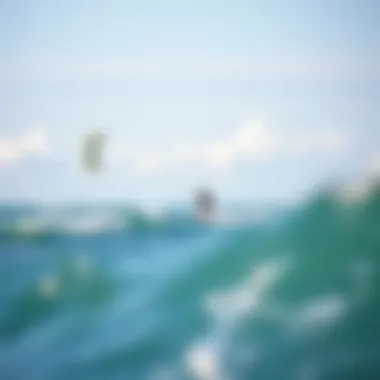
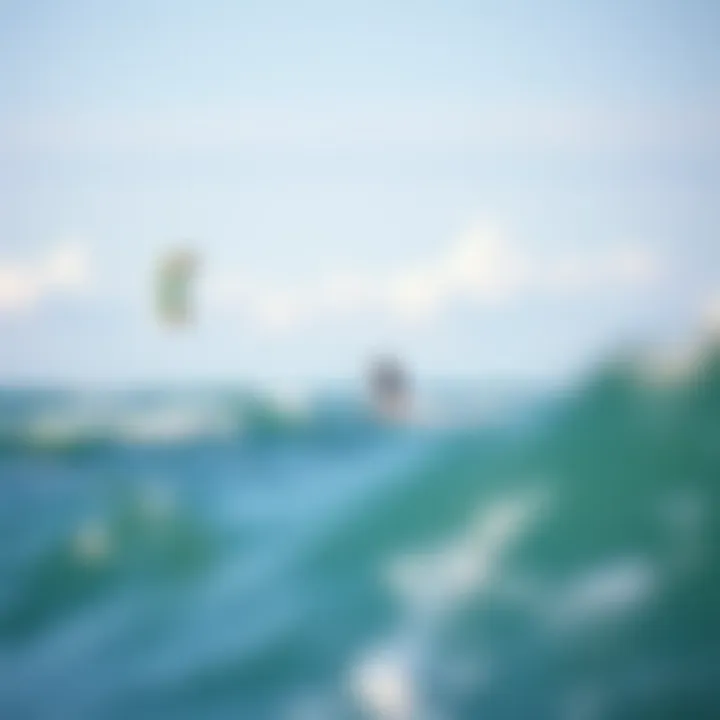
What you can expect in your initial lessons:
- Ground Handling: The first order of the day often includes learning how to handle the kite on land. You will practice launching and landing, getting comfortable with the control bar, and understanding how the kite responds to your inputs.
- Water Safety: Understanding safety measures is paramount. Instructors typically run a safety briefing, ensuring that you are aware of the surrounding environment, potential risks, and your equipment.
- First Flights: After you’ve gotten a hang of ground handling, you might take your first flights on the water. The focus here is on getting your kite in the air and experiencing the sensation of being pulled by the wind.
Each of these elements is critical in laying the groundwork for your skills. The ultimate goal is to build your confidence before you begin to tackle more complex maneuvers.
Progressing to Intermediate Skills
Once you’ve got the hang of the basics and are feeling comfortable, it’s time to dive deeper into the fun stuff. Intermediate lessons are all about developing control and finesse over your kite and board. This is where the rubber meets the road—or in this case, where you hit the water.
- Riding Technique: You’ll start focusing more on how to ride efficiently, maintaining your balance and improving your turning ability. This might involve practicing transitions, which is the maneuver of switching directions smoothly.
- Controlled Jumps: If you’re feeling buoyant about your progress, instructors often begin to introduce small jumps. Learning to take off and land properly is essential. You’ll want to master your timing with the kite for smooth takeoffs.
- Using the Wind: Grasping the wind’s dynamics is crucial. You’ll learn to analyze the wind pattern, optimizing your positioning to gain the most out of every gust.
Realizing your potential at this stage can be incredibly fulfilling. But remember, patience is key. Each step builds upon the last, ensuring you progress in a safe manner.
Advanced Techniques and Maneuvers
For those who have reached a level of comfortability and control, advanced techniques can feel like a thrilling roller coaster of excitement. At this stage, the spectrum opens up; you can now explore a world of new tricks and styles.
- Jumping Higher: Advanced lessons will help you to refine your jumps—focus on your technique, the timing, and landing strategy. Fine-tuning these elements can lead to exhilarating experiences on the water.
- Complex Tricks: Once you have mastered basic jumps, tricks like spins, flips, and grabs come into play. The precision involved here provides a new layer of challenge.
- Race Techniques: Those with an interest in speed may delve into race techniques. This involves strategy, kite control, and optimizing your performance in competitive settings.
Advancing your skills is not merely about showmanship though; it’s about gritting through failures and celebrations alike and gaining independence on the water. Embracing this phase will allow you to uniquely express yourself as you ride the waves.
"Kite surfing takes patience, practice, and a sense of adventure. Embrace the learning process, and the rewards will follow."
Following this structured learning process not only enhances your skills but also builds a community around the joy of kite surfing. By gradually moving through each phase, you become part of a vibrant, dynamic sporting culture.
Safety Considerations in Kite Surfing
Kite surfing is an exhilarating sport, yet it comes with its fair share of risks. Safety considerations in kite surfing are paramount. Ensuring a safe experience not only protects the kiteboarder but also makes the learning process more enjoyable. Incorporating proper safety measures can prevent accidents and enhance the overall enjoyment of the sport. The following subsections delve into significant aspects of kite surfing safety, from pre-lesson briefings to emergency protocols.
Pre-Lesson Safety Briefing
A pre-lesson safety briefing is the foundation of a secure kite surfing experience. This briefing is typically conducted by the instructor and sets the stage for understanding the environment and equipment. During this session, several critical elements are covered:
- Equipment Inspection: Instructors will show how to check kites, lines, and safety gear for damages or wear. A well-maintained setup is your first defense against mishaps.
- Wind Conditions: Learning how to read the wind is vital. Instructors will explain how varying wind strengths can impact performance and safety.
- Understanding Signals and Communication: Clear communication is essential on the water. The instructor will establish hand signals or verbal commands used during the lesson, promoting better coordination among participants.
By the end of the briefing, kiteboarders leave with a clearer head, ready to hit the water with a solid understanding of how to stay safe.
Risk Management on Water
When kite surfing, managing risks on the water involves awareness of both your surroundings and your own capabilities. Here are some key points to keep in mind:
- Avoiding Crowded Areas: It’s wise to steer clear of heavy traffic zones where several kite surfers are present. More people mean higher chances of collision.
- Understanding the Environment: Be aware of nearby boats, swimmers, or other hazards that could interfere with your ride. For instance, rocky shores, strong currents, or low tides can pose dangers, so be cautious and plan your route accordingly.
- Kite Control Techniques: Mastering kite control is crucial for safety. Practicing relaunching a downed kite or knowing how to depower in strong winds can save you in critical situations.
Risk management requires constant vigilance and respect for the elements at play.
Emergency Protocols
No one wants to consider the worst-case scenario while kite surfing, but having robust emergency protocols in place is essential. Here’s what you should be ready for:
- Emergency Procedures with Instructors: Every kite surfing lesson should outline specific steps to take in case of an emergency. The instructor will usually demonstrate everything from how to signal for help to how to retrieve someone in difficulty.
- First Aid Readiness: Having a first aid kit on hand is a must. Instructors should have basic first aid knowledge and know how to treat common injuries, such as cuts or sprains.
- Recovery Plans: In cases where a kite gets uncontrollably caught up, knowing how to handle such situations minimizes risk. Instructors often go through how to safely descend from the kite or manage entangled lines.
By integrating these emergency protocols into your routine, you ensure that you’re prepared for anything that might occur on the water. Ultimately, safety in kite surfing means being proactive, aware, and prepared for the surprises that nature can throw your way.
"Safety first. It’s better to be safe than sorry, especially when dealing with the untamed forces of nature."
This approach not only keeps the fun intact but also fosters a positive learning environment for all involved.
Gear Maintenance and Care
Taking care of your kite surfing equipment is essential for both safety and performance on the water. Proper maintenance ensures longevity and optimal function of your gear, holding together the vital pieces that make kite surfing a thrilling experience. Neglecting your gear can lead to poor performance and, worse yet, safety risks. This section will cover key aspects of how to clean and maintain both kites and other equipment, reminding you that a little care can go a long way.
Cleaning and Drying Kites
Cleaning your kite isn’t just a matter of aesthetics; salt, sand, and moisture can wreak havoc on its fabric and components. After a day on the water, it’s a good practice to rinse your kite with fresh water. Focus on these points:
- Take it Easy on the Sand: Always try to keep your kite off the sand. Use a tarp or a clean beach towel to prevent sand from getting into the seams.
- Rinse Thoroughly: After your session, rinse your kite inside and out with fresh water. Pay special attention to the leading edge and trailing edge, as this is where dirt accumulates.
- Dry Before Storing: After washing, ensure that your kite is thoroughly dried before you store it away. Leaving a damp kite can encourage mold growth and degradation of the fabric.
Ultimately, a clean kite not only performs better but also enhances your enjoyment on the water. Regularly cleaning your kite will also help you spot any wear or tear early on, allowing for timely repairs.
Storing Equipment Properly
Proper storage is another crucial aspect of gear maintenance, significantly contributing to the lifespan of your equipment. It’s not just about cramming your gear into a closet; the correct approach can impact all aspects of your kite. Here are some considerations for effective storage:
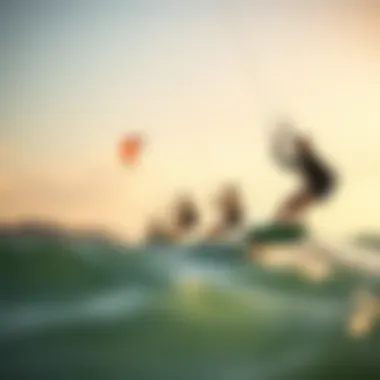
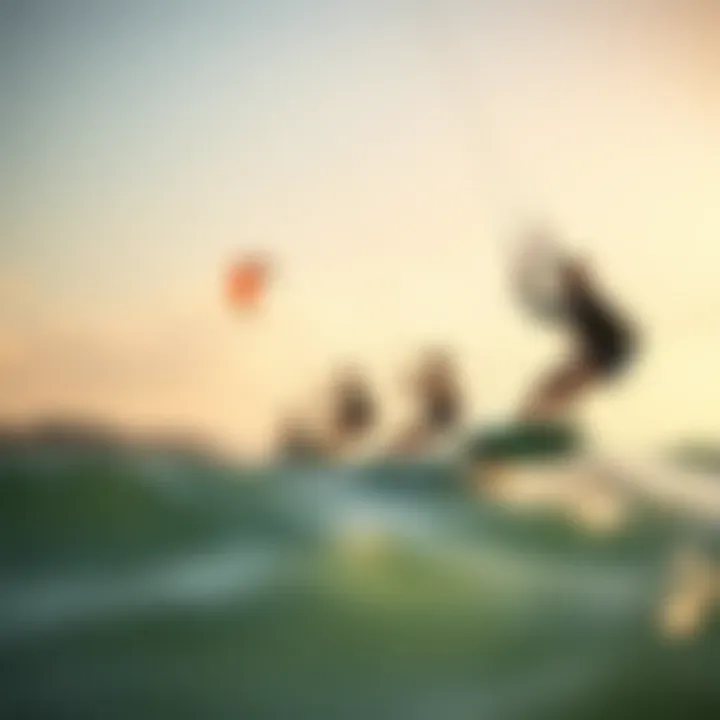
- Cool and Dry Place: Store your gear in a place that is cool, dry, and away from direct sunlight. Heat and UV rays can degrade the materials significantly.
- Avoid Overstuffing: When putting your kite and board away, avoid folding and stuffing it tightly into bags. This can cause creases and compromise the structure.
- Use Specific Gear Bags: Invest in good-quality bags specifically made for kite equipment. They provide necessary cushioning and protection from bumps and bruises while stored.
Storing your equipment correctly means less wear and tear and fewer repairs down the line. Following these guidelines will ensure that you’re always set up when you’re ready to hit the water.
Remember: A stitch in time saves nine. Taking care of your equipment today pays off in the long run.
For more information on kite maintenance and care, you can check resources like Wikipedia and Reddit's Kiteboarding community.
Best Locations for Kite Surfing Lessons
Selecting the right setting for kite surfing lessons can make all the difference. The ideal location not only enhances the learning experience but also ensures safety and conducive conditions for beginners and advanced kite surfers alike. When you’re aiming to master the waves, being in a favorable environment can boost your confidence and skill acquisition. Locations with suitable wind patterns, water conditions, and access to instructors are key elements to take into account.
Ideal Spots for Beginners
When starting out, it’s crucial to choose locations that provide calm water and reliable winds. Here are some prime spots that stand out for newcomers:
- Maui, Hawaii: With its warm waters and consistent breezes, Maui is a fantastic spot for beginners. The gentle waves make it easier to learn and the variety of schools available opens up many options.
- Tarifa, Spain: Known as the kite surfing capital of Europe, Tarifa offers a mix of flat water and waves. Beginners can find sheltered areas that allow for safer practice.
- Silvaplana, Switzerland: Nestled amidst mountains, this location has predictable winds—ideal for beginners seeking stability as they learn.
Many of these places also boast local schools that offer tailored lessons, catering especially for novices. It’s wise to attend a few sessions in different conditions to appreciate how they affect your learning experience.
Intermediate and Advanced Locations
As skills progress, kiteboarders begin to explore more challenging conditions and landscapes. Here are several locations that cater to intermediate and advanced surfers:
- Cape Town, South Africa: This city offers a striking contrast with its strong winds and rough waters, perfect for those looking to sharpen their technical skills through challenging conditions.
- Cumbuco, Brazil: Known for its ideal wind conditions year-round, Cumbuco presents consistent strong breezes and a vibrant kiteboarding community, making it great for advanced maneuvers.
- Hatteras, North Carolina: The wide variety of wind conditions here provides ample opportunities to experiment with different styles—great for those wanting to refine their skills.
Advancing in kite surfing often means testing one’s limits, so it’s essential to choose locations that push your boundaries while ensuring safety. Consulting with local instructors about conditions and hazards can also provide crucial insights for a rewarding experience.
"The right place can elevate your skills like a good wind lifts your kite," seasoned kite surfers often say. Finding optimal locations ensures you can focus on mastering techniques without undue distractions from challenging elements.
In summary, wherever you choose to begin your kite surfing journey or advance your skills, picking the right spot is instrumental. Emphasizing safe, suitable, and supportive environments can pave the way to significant progress in your kite surfing adventure.
Kiteboarding Community and Resources
The kiteboarding community provides more than just a network of enthusiasts; it serves as a vital resource to enhance learning, foster connections, and share experiences. Being part of this community can profoundly impact one's progress and enjoyment in kite surfing. From local clubs that offer hands-on opportunities to online platforms that ensure information is just a click away, the importance of these resources cannot be understated.
Local Kiteboarding Clubs
Local kiteboarding clubs are hubs for enthusiasts of all levels. Joining a club can give newcomers a fast track to getting involved in the sport. These establishments often organize lessons, group outings, and competitions, which can be fantastic for learning. You might also find mentorship opportunities there, as experienced riders often take the time to assist those just starting out. Chew on this: when you surround yourself with like-minded folks who share the same passion for kiteboarding, it can quickly help you feel at home on the water.
Here are some benefits of local kiteboarding clubs:
- Structured Lessons: Clubs typically offer structured lessons that cater to various skill levels, ensuring that everyone can find a class that suits their needs.
- Shared Equipment: Many clubs provide access to gear for members, which means you can try before you buy.
- Social Events: Participate in a wide range of social events from BBQs to competitions. These opportunities help build camaraderie among members.
- Community Support: Being part of a club allows you to tap into the collective knowledge and experience of fellow members.
Online Forums and Resources
Online forums and platforms have transformed the way kiteboarders connect and share information. Whether you're looking for advice on specific techniques or pondering what gear to purchase, these resources are indispensable. Websites like Reddit’s kiteboarding community reddit.com/r/kiteboarding offer a blend of novice inquiries and expert discussions.
Here are a few perks of engaging with online resources:
- Diverse Perspectives: Online forums allow users to post questions, receive answers, and read discussions that span various experiences and methodologies.
- Access to Tutorials: Many amateur and professional kiteboarders share video tutorials online. You can find everything from beginner basics to advanced tricks.
- Marketplace Features: Some forums include marketplaces where users can buy, sell, or trade gear, making it easier to find the right equipment.
- Global Network: Online platforms connect you with kiteboarders from all over the world, giving you insight into different styles and techniques.
"Joining a kiteboarding community, whether local or online, opens doors not just to learning but also to lifelong friendships and unforgettable experiences."
In summary, the kiteboarding community and its resources play an invaluable role in enriching your kite surfing journey. From local interactions to global conversations, these connections enhance the learning experience and inspire continual growth in the sport.
The End on Kite Surf Lessons
The final thoughts on kite surf lessons crystallize a journey that is as much about personal growth as it is about mastering a sport. Throughout this article, we have dissected various aspects from the nuts and bolts of equipment to the nuances of safety and the vibrant community that surrounds kite surfing. As you close this chapter, it's clear that engaging in kite surf lessons is more than just learning how to harness the wind while gliding over water. It's about building confidence, honing skills, and perhaps most importantly, fostering connections with like-minded enthusiasts.
Lifelong learning is an integral component in any endeavor, especially in water sports where new techniques and technologies continually evolve. Investing time in quality lessons not only enhances your performance but significantly reduces the risk of accidents. This isn’t just about riding the waves; it’s about riding them smartly. Take note that the practical experience gained during lessons builds the foundation upon which all future achievements in kite surfing are made.
In essence, kite surf lessons are essential for anyone looking to embrace both the thrill and the methodical aspects of this exhilarating sport. The artistry in mastering kite control translates into a more enjoyable, safe, and rewarding experience on the water.
Reflecting on the Learning Journey
Reflecting on your learning journey in kite surfing unveils a rich tapestry of experiences, revolving around personal triumphs and challenges. When you first step onto the water, you're not just learning to control a kite; you’re embarking on a unique rite of passage. Those initial moments can be daunting yet exhilarating, as you're faced with the raw power of the elements. The feeling of the wind tugging at your harness and the water splashing beneath your board evokes a sense of freedom that is hard to find elsewhere.
Many learners discover that each lesson is layered with insights, beginning with understanding the mechanics of how kites work. As you progress, you build upon the foundational skills, gradually moving from the safety of learning how to launch and land, to more advanced maneuvers like jumps and tricks. This progression often reflects your personal growth, marked by increasing confidence and capability.
What stands out during this reflective phase is the community support. Fellow learners and instructors often celebrate milestones together; it creates bonds that can spur long-lasting friendships. Sharing laughter and frustrations within a group can transform the learning process into something even more enriching—it's more than just about surf; it's about connections.
Next Steps in Your Kiteboarding Adventure
Once you’ve completed your initial lessons, you may find yourself bubbling with excitement for what lies ahead. Your next steps in this kiteboarding adventure hinge on a few strategic considerations. First, keep engaging with the kite surf community. There are always meet-ups, local clubs, and events that foster growth and camaraderie.
Secondly, continue to challenge yourself. After gaining a basic level of comfort, it might be time to explore advanced lessons with specialized instructors who can guide you through complex strategies, from jumping higher to executing turns seamlessly. Consider trying various boards or kites to see what suits your style best—sometimes the smallest changes can lead to the biggest improvements.
Lastly, document your progress. Keeping a journal of your kite surfing experiences not only helps track improvements but also encourages reflection on what you've learned and where you wish to go next. Take photographs or videos to capture your journey; reviewing these materials can often reveal just how far you’ve come. Compare your first wobbly water starts with those smooth landings after a solid jump—it can be a powerful motivator to keep pushing your limits.
With these next steps, you're well-poised to embrace the exhilarating world of kite surfing. Like the wind that propels your kite, let your curiosity drive you forward as you continue to grow and explore.















